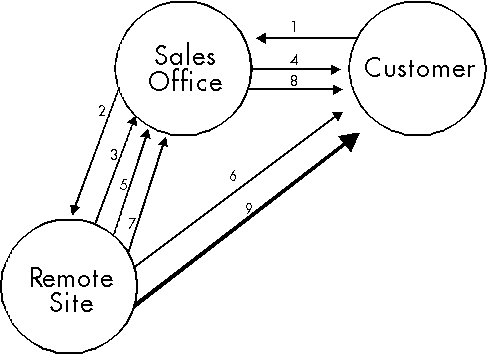Documentation >
MAC-PAC Reference Library >
Distribution >
Electronic Data Interchange >
Key Concepts and Procedures >
MAC-PAC's EDI Capabilities >
Transaction Overview
Transaction Overview
The Electronic Data Interchange module is an application-to-application exchange of inter-company business data in structured, standard formats. MAC-PAC's EDI application supports several types of transactions, allowing users to tailor the basic application areas to more closely meet their unique requirements. The transactions supported by EDI include:
|
|
ANSI Transaction Equivalent
|
|
Outbound Purchase Orders
|
ANSI transaction #850
|
|
Inbound Sales Orders
|
ANSI transaction #850
|
|
Outbound Sales Order Acknowledgments
|
ANSI transaction #855
|
|
Inbound Purchase Order Acknowledgments
|
ANSI transaction #855
|
|
Outbound Shipments/BOLs
|
ANSI transaction #856
|
|
Inbound Receipts
|
ANSI transaction #856
|
|
Outbound Invoices
|
ANSI transaction #810
|
The figure below shows the MAC-PAC transactions that can be transmitted via EDI. For more detailed information about each EDI transaction, see the EDI Transactions Overview key concept. These transactions can be used in Computer Integrated Distribution (CID) environments and vary slightly depending on whether they are executed at a sales offices, remote sight, or customer location. However, each transaction is just as effective outside a CID environment. For more specific information on CID processing, refer to the CID Overview key concept in the Order Processing or Purchasing User Manuals.

CID Transaction Scenario
Transactions 1-8 can be transmitted via EDI.
The following table describes each of the transactions shown above along with its associated EDI Transaction file. The files associated with each transaction must be populated in order to transmit the transaction via EDI.
|
|
Transaction Sent from
(Type of Transaction)
[EDI Transaction File]
|
Transaction Sent to
(Type of Transaction)
[EDI Transaction File]
|
|
1
|
Customer
(Outbound Purchase Order)
[PO630AP1-4]
|
Sales Office
(Inbound Sales Order)
[ED140AP1-4]
|
|
2
|
Sales Office
(Outbound Purchase Order)
[PO630AP1-4]
|
Remote Site
(Inbound Sales Order)
[ED140AP1-4]
|
|
3
|
Remote Site
(Outbound SO Order Acknowledgment)
[OP520AP1-2]
|
Sales Office
(Inbound PO Order Acknowledgment)
[ED100AP1-2]
|
|
4
|
Sales Office
(Outbound SO Order Acknowledgment)
[OP520AP1-2]
|
Customer
(Inbound PO Order Acknowledgment)
[ED100AP1-2]
|
|
5
|
Remote Site
(Bill of Lading)
[OP695AP1-3]
|
Sales Office
(Inbound PO Receipt)
[ED120AP1-3]
|
|
6
|
Remote Site
(Bill of Lading)
[OP695AP1-3]
|
Customer
(Inbound PO Receipt)
[ED120AP1-3]
|
|
7
|
Remote Site
(Outbound A/R Invoice)
[OP540AP1-4]
|
Sales Office
(AP Invoice--done manually)
[not an EDI transaction]
|
|
8
|
Sales Office
(Outbound A/R Invoice)
[OP540AP1-4]
|
Customer
(AP Invoice--done manually)
[not an EDI transaction]
|
|
9
|
Remote Site
(Inventory Shipment)
[not an EDI transaction]
|
Customer
(Receiving Inventory)
[not an EDI transaction]
|
CID Transactions, Areas of Origin and Destination, and EDI Transaction Files
Transactions 1-8 can be transmitted via EDI.